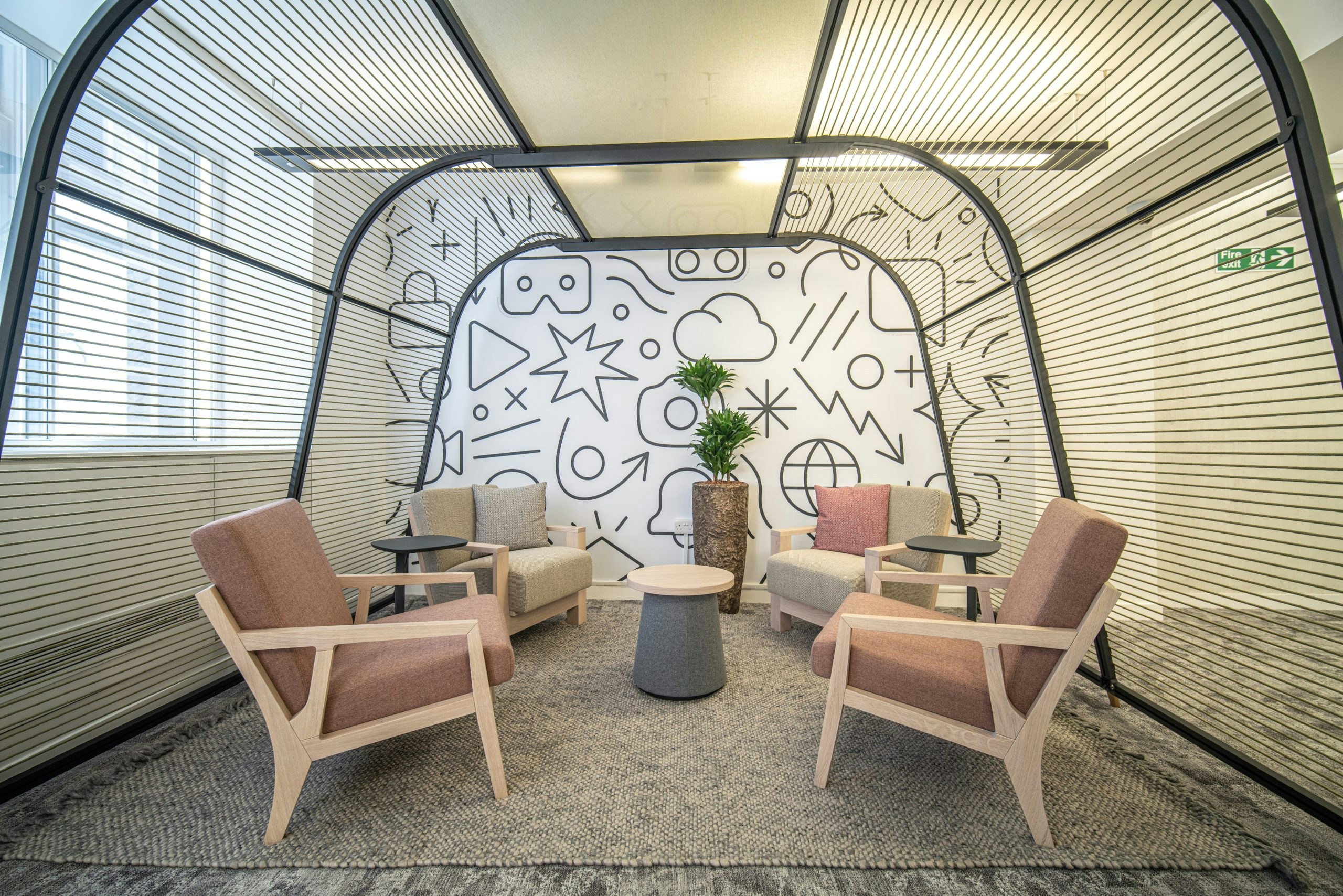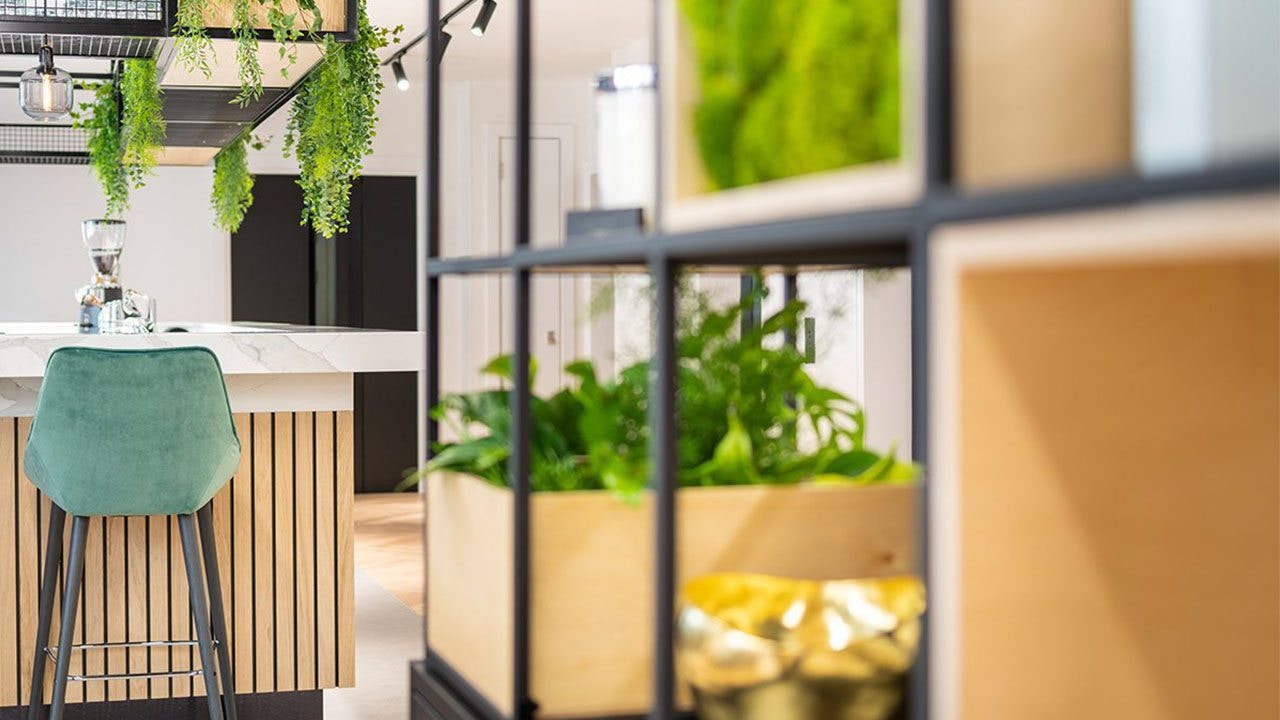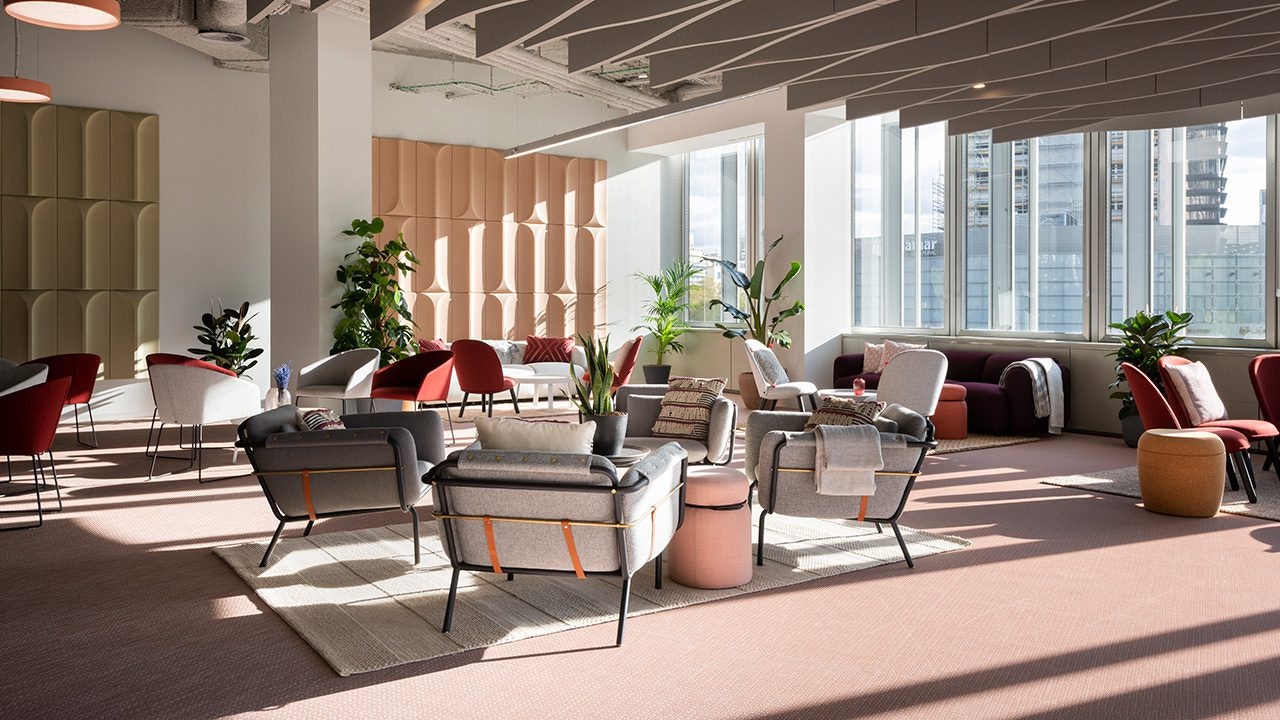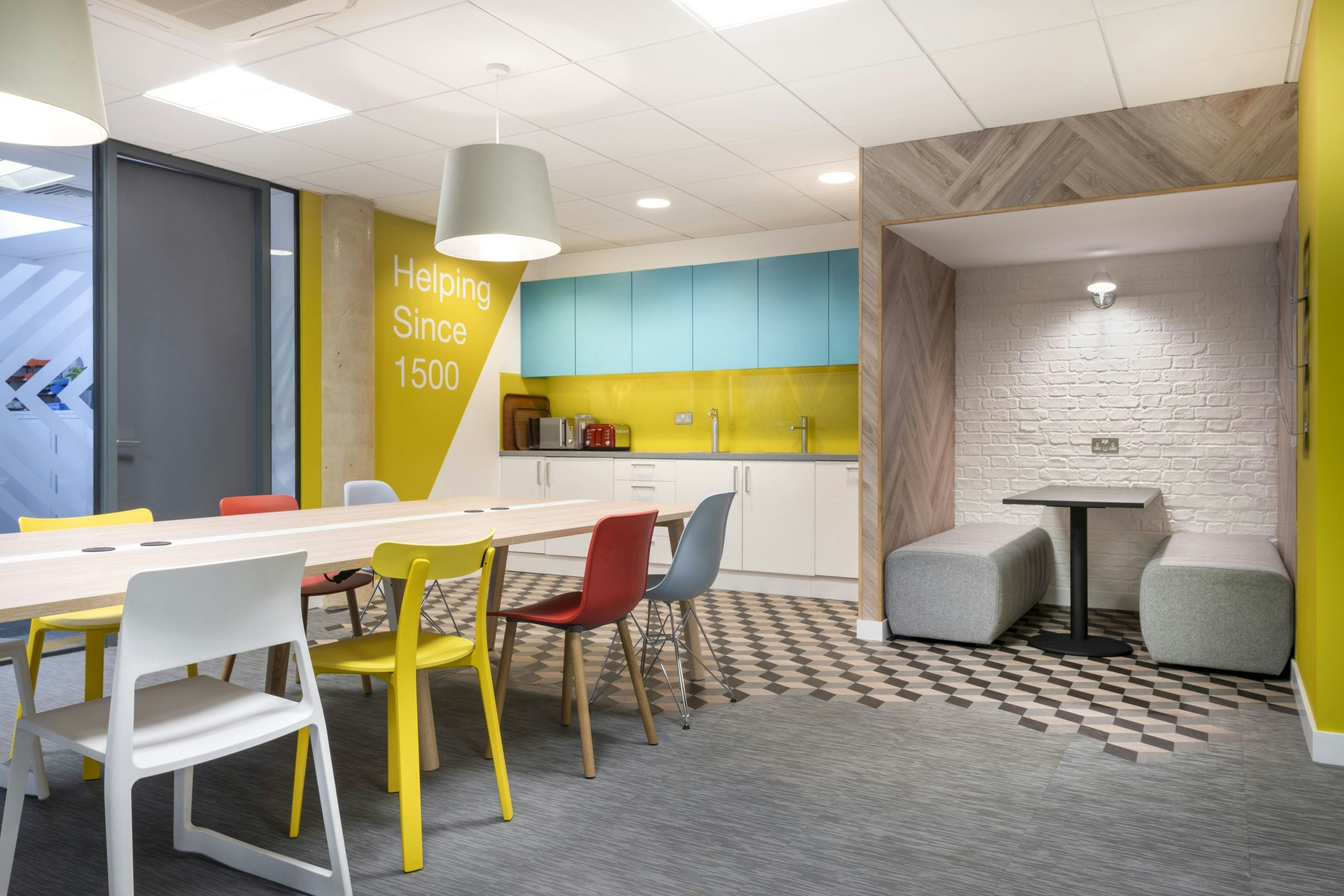Workplaces are changing in exciting ways. We’ve gathered together some key office design trends for 2025, which we hope will serve you as a toolbox of ideas to inspire your next office refurbishment or fit-out project.

Office Design Trends for 2025
Workplaces are changing in exciting ways. Here’s a concise toolbox of the key office design trends for 2025, from smart buildings and reconfigurable multi-use spaces to wellness, sustainability, inclusive design, and hospitality-inspired amenities to inspire your next refurbishment or fit-out.
Office Design Trends in 2025
- 1. The Rise of Smart Buildings
- 2. Reconfigurable Multi-Use Workspaces
- 3. Employee Wellness and Mental Wellbeing
- 4. Sustainability and Eco-Friendly Practices
- 5. Natural Lighting and Open Layouts / Bioclimatic Spaces
- 6. Inclusive and Neurodiverse Spaces
- 7. Collaborative and Social Spaces
- 8. Acoustic Spaces
- 9. Integrated Hospitality and Amenity Spaces
- 10. Branding, Culture, and Identity
1. The Rise of Smart Buildings
The United Kingdom’s technology sector has a market valuation of approximately £1 trillion and is home to 171 unicorns. In 2023 alone, UK tech startups raised around £17.3 billion, primarily across London, the East of England, and the South East. The sector encompasses over 85,000 startups and scale-ups, spanning AI, fintech, health tech, and sustainability, all fuelled by world-class research and supportive government policy.
Amid this fast-paced evolution, smart building technologies are emerging as a key frontier—redefining how workspaces function across the UK. In particular, the rise of generative AI systems is streamlining operations by automating routine tasks, optimising energy use, and delivering real-time insights into space utilisation. These innovations enable organisations to cut costs, reduce environmental impact, and enhance workplace efficiency.
More recently, the emergence of agentic AI—capable of making autonomous decisions—has accelerated the shift toward hyper-personalised work environments. These systems can intelligently adjust lighting, temperature, and air quality in real time, creating spaces tailored to individual comfort and productivity needs. The result is a more adaptive, human-centric workplace experience.
The physical workspace is also becoming smarter. Furniture equipped with built-in charging ports, wireless connectivity, and integrated technologies ensures that employees remain connected and equipped throughout the day. These innovations go beyond convenience—they’re reshaping offices into fully integrated, tech-enabled ecosystems designed for collaboration, efficiency, and wellbeing.

2. Reconfigurable Multi-Use Workspaces
The rise of diverse work styles and hybrid working models has increased demand for reconfigurable, multi-use workspaces that adapt to varying needs. At the heart of these spaces is adaptable furniture, such as modular shelving, desks, and tables, which can be easily reconfigured. This flexibility supports everything from focused individual tasks to collaborative team projects, ensuring that workspaces remain functional and versatile.
Balancing hot-desking with dedicated desks is essential in these environments. Hot-desking fosters flexibility and maximises space utilisation, while dedicated workstations provide continuity and a productivity boost for individuals or teams requiring consistency. This hybrid-friendly approach appeals particularly to start-ups and remote teams prioritising adaptability and efficiency.
In addition to traditional work functions, modern offices increasingly require spaces tailored for content creation. Reconfigurable spaces incorporate features like folding walls, mobile tables, and stackable furniture to facilitate activities such as podcasting, video production for social media feeds and media walls to engage with external team members. These adaptable zones allow businesses to seamlessly transition between brainstorming sessions, studio setups, and formal meetings or casual breakout areas—all within the same workspace.
3. Employee Wellness and Mental Wellbeing
Prioritising employee wellness and mental wellbeing is increasingly recognised as essential to creating productive and satisfying work environments. Biophilic design, which integrates plants, greenery, and other natural elements, offers proven benefits for mental health and productivity. By connecting employees to nature, these designs reduce stress and promote a sense of calm, supporting both focus and creativity.
Wellness rooms provide quiet spaces for relaxation, meditation, or mental health support, allowing employees to recharge and maintain balance throughout the day. Ergonomic solutions, such as adjustable sit-stand desks, supportive chairs, and health-conscious layouts, further contribute to long-term wellbeing by improving posture, reducing strain, and enhancing comfort.
Acoustic solutions address the challenges of noise and distraction in the workplace. Soundproof pods and quiet zones create environments ideal for video calls, deep-focus work, or noise-sensitive tasks. By integrating these wellness-focused elements, businesses demonstrate a commitment to employee care, fostering a healthier, happier, and more engaged workforce.
4. Sustainability and Eco-Friendly Practices
Sustainability is at the forefront of modern workplace design, with organisations increasingly adopting eco-friendly practices to align with corporate Environmental, Social, and Governance (ESG) goals. Circular design is a key driver, focusing on the reuse of furniture and materials, up-cycling where possible, and minimising waste. By reducing carbon footprints and considering the life cycle of materials, workplaces contribute to a sustainable future while lowering operational costs.
Energy efficiency is another cornerstone of eco-friendly office design. Smart lighting systems that adjust to natural light levels, advanced climate control technologies, and energy-saving devices ensure sustainable operations without compromising comfort. These innovations not only reduce energy consumption but also reflect corporate responsibility and environmental stewardship.
The use of sustainable materials further enhances the green credentials of modern workplaces. From eco-friendly furnishings to non-toxic finishes, every detail is chosen to minimise environmental impact. By embracing these practices, organisations demonstrate a commitment to sustainability, fostering an eco-conscious culture that resonates with employees and stakeholders alike.
5. Natural Lighting and Bioclimatic Spaces
Natural lighting and open layouts are transformative design strategies that breathe life into modern workspaces. By prioritising sunlight through large windows, glass partitions, and intelligent architectural choices, organisations create environments that enhance employee wellbeing and reduce energy consumption. These thoughtful designs allow daylight to penetrate deeply into workspaces, fostering a positive atmosphere that feels both vibrant and calming while significantly reducing reliance on artificial lighting.
Green building standards like WELL and BREEAM are reshaping workplace design by establishing comprehensive guidelines for sustainable and healthy environments. These certifications go beyond aesthetic considerations, promoting energy-efficient practices, improved indoor air quality, and the use of environmentally responsible materials. They ensure that workplaces are not just functional spaces, but strategic investments that reflect an organisation’s commitment to employee health and environmental sustainability.
By integrating bioclimatic principles, companies create workspaces that blur the boundaries between indoor comfort and natural elements. These designs recognise that our physical environment profoundly influences creativity, productivity, and overall wellbeing. The result is a holistic approach to workplace design that supports human potential while simultaneously addressing broader environmental challenges, demonstrating that beautiful, functional spaces can be both inspiring and responsible.
6. Inclusive and Neurodiverse Spaces
Creating inclusive workspaces that cater to neurodiverse and diverse needs is essential for fostering a supportive and productive environment. Sensory considerations are crucial, with designs incorporating varied lighting, soundproof zones, and flexible layouts. These features accommodate different sensory preferences, enabling neurodivergent employees to thrive.
Accessible design ensures that workspaces meet high standards for physical and cognitive accessibility. This includes wheelchair-accessible layouts, adjustable desks, and clear navigation systems, creating environments that are welcoming and functional for all employees, regardless of their abilities.
Diverse feedback systems further enhance inclusivity by actively involving employees in shaping their environment. By gathering input on design and functionality, organisations can create offices that reflect the diverse needs of their workforce. Together, these practices foster equitable spaces and cultivate a sense of belonging and empowerment among all employees.
7. Collaborative and Social Spaces
Collaborative and social spaces are essential in modern workplaces, fostering connection, teamwork, and creativity. Enhanced meeting areas equipped with state-of-the-art technology, such as seamless video conferencing tools, support hybrid collaboration by enabling effective communication between in-person and remote team members. These tech-enabled rooms break down barriers to innovation and productivity.
Social zones play an equally vital role, offering informal spaces where employees can interact and build relationships. Whether it’s a lounge area or a café-style setup, these zones encourage casual conversations that often lead to meaningful collaborations and stronger team bonds.
Informal seating, with movable and comfortable furniture, adds flexibility to these spaces, allowing employees to rearrange setups to suit their needs. This adaptability supports spontaneous collaboration and dynamic team interactions. Together, these collaborative and social spaces balance productivity with human connection, creating a vibrant and engaged workforce.
8. Acoustics and Soundproofing
As employees return to the office more frequently, many organisations are encountering increased noise levels, which can disrupt concentration and reduce productivity. Studies have shown that background noise can lead to a 66% drop in productivity, with conversations among colleagues being a significant source of distraction.
Acoustic spaces are vital in modern office design, especially in open-plan environments where noise can disrupt focus and productivity. Soundproof pods offer quiet retreats for tasks requiring concentration, virtual meetings, or phone calls, enabling employees to work without distractions. These pods provide a private and peaceful solution within busy office settings.
For larger teams, soundproof zones with booths and enclosed areas cater to activities like deep-focus work or collaborative discussions while minimising noise interruptions. Acoustic partitioning systems, featuring modular and moveable partitions with sound-absorbing materials, allow flexible reconfiguration of workspaces while maintaining effective noise control.
To further enhance office acoustics, ceiling and wall treatments with acoustic panels, baffles, and tiles reduce sound reverberation and improve speech clarity. Soft furnishings like carpets, upholstered furniture, and curtains add an extra layer of sound absorption, creating a balanced auditory environment. Together, these solutions transform workplaces into productive, harmonious spaces that support diverse tasks and workstyles.
9. Integrated Hospitality and Amenity Spaces
Modern workplaces are increasingly incorporating hospitality-inspired amenities to enhance the employee experience and foster a sense of community. Café-style breakout areas featuring barista coffee points, healthy snack bars, and comfortable lounge spaces provide inviting zones for relaxation and informal collaboration. These spaces encourage meaningful interactions and help employees recharge during the workday.
In addition to breakout areas, wellbeing amenities such as on-site fitness centres, yoga studios, nap pods, and dedicated relaxation zones reflect a growing focus on holistic employee health. These facilities support both physical and mental wellbeing, promoting a more balanced and productive workplace culture.
Concierge services further enhance convenience by transforming reception areas into hubs of support. Offering assistance with logistics, IT troubleshooting, or even personal errands, these services allow employees to focus on their work while enjoying the benefits of a seamless and supportive environment. By integrating hospitality and amenity spaces, organisations create vibrant workplaces that prioritise both employee satisfaction and collaboration.
10. Branding, Culture, and Identity
Workplace design is an opportunity to showcase a company’s brand, culture, and identity, transforming the office into a physical representation of its values and ethos. Branded environments incorporate storytelling elements, such as logos, mission statements, and visual motifs, seamlessly blending them into the design. These details not only reinforce the company’s image but also create a sense of pride and belonging among employees.
Cultural zones further enhance the workplace by reflecting organisational identity and celebrating diversity. Whether through spaces dedicated to company milestones, areas showcasing employee achievements, or zones that foster inclusivity, these designs create meaningful connections and amplify a sense of community within the workplace.
Customisation is key to creating a truly unique environment. Custom furniture and finishes, tailored to the organisation’s aesthetic, differentiate the workspace while enhancing brand recognition. These personalised design elements elevate the office from a functional space to a cohesive environment that embodies the company’s identity and vision.









